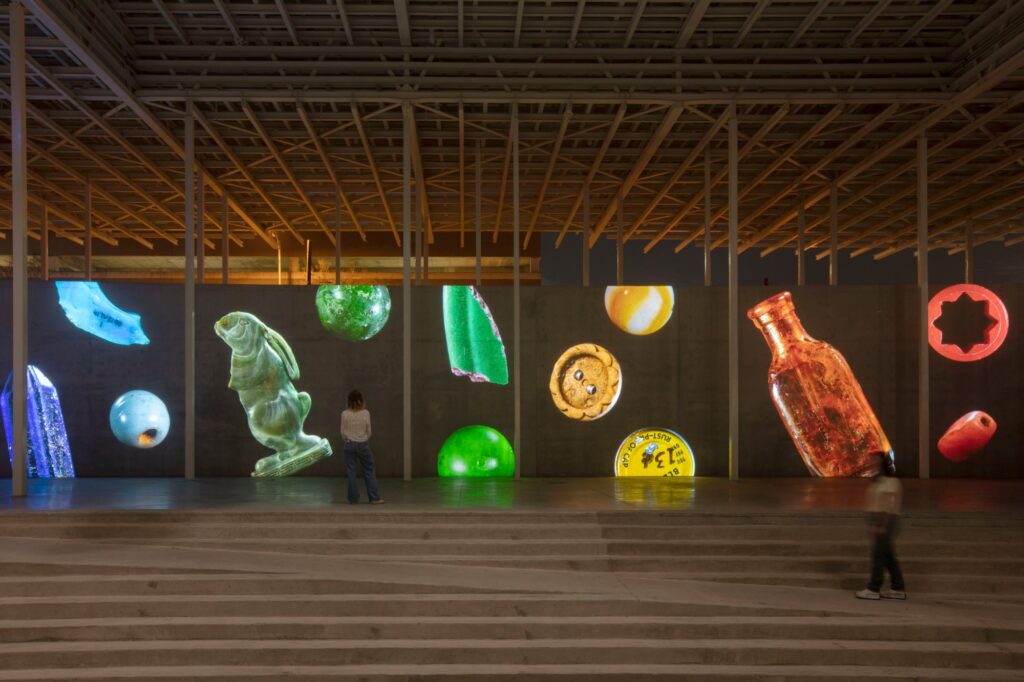In a city like Austin, where modernity intertwines with history at every corner, it’s easy to overlook the layers of lives and cultures that once thrived beneath the surface. Teresa Hubbard and Alexander Birchler’s “Past Deposits from a Future Yet to Come” invites us to pause, reflect, and reconsider our relationship with the land beneath our feet. Premiering at Austin’s Moody Amphitheater in Waterloo Park, this 27-minute video installation illuminates not only the amphitheater itself but also the hidden stories of those who once inhabited this place.
A Monument to the Forgotten
Projected across the amphitheater’s massive 16-by-120-foot stage, the film depicts an array of artifacts—buttons, pottery shards, marbles, glass bottles, and more—seemingly tumbling down the screen in slow, deliberate motion. These objects, unearthed from the Waterloo Park area, tell stories of communities that lived in this very space long before the park was a gleaming modern public venue. Each item, however small, holds a world of meaning. Among the most striking is a terracotta frog, a piece that seems mundane on the surface but resonates with deep historical significance when viewed in the context of Austin’s complex, multi-layered past.
At its heart, “Past Deposits from a Future Yet to Come” is a tribute to the communities whose histories are often marginalized or erased in the narrative of modern urban development. Indigenous tribes, African American families, and Mexican immigrants all left their mark on this land over the past two centuries, only to be displaced by forces beyond their control. Through meticulous research, Hubbard and Birchler uncovered the artifacts that are now central to their film, preserved for decades in storage at the Texas Archaeological Research Laboratory at the University of Texas at Austin. These relics—once hidden—are now brought into public view in an act of artistic reclamation.
Uncovering the Past Through Art
The act of unearthing, both literal and metaphorical, is central to the project. The artists did not merely stumble upon these objects but actively sought them out, conducting research into the excavation of Waterloo Park’s history. In this way, the film functions as both a visual spectacle and an archaeological exploration, bridging the gap between art and history. As the objects fall across the screen, viewers are reminded that the ground beneath them holds traces of lives that were lived, lost, and often forgotten.
One of the most compelling aspects of the installation is its interplay with the amphitheater’s physical environment. Moody Amphitheater, a sleek, modern space, is itself a symbol of Austin’s rapid urbanization and cultural renaissance. In juxtaposing this contemporary structure with artifacts from the past, Hubbard and Birchler create a tension between the present and the forgotten. The amphitheater becomes not just a venue for entertainment but a canvas for reflection on the deep-seated histories that continue to shape the city.
The Historical Context of Waterloo Park
Waterloo Park, where the amphitheater is located, sits along the banks of Waller Creek—a waterway that has long been central to Austin’s development. Over the past two centuries, this area has seen wave after wave of human settlement. Indigenous peoples first inhabited the banks of Waller Creek, followed by African American communities, many of whom were formerly enslaved, and later Mexican immigrants. These communities made their homes in what was once a flood-prone, yet vibrant area. Over time, however, a combination of natural disasters and urban policies rooted in segregation gradually displaced these residents, leaving little behind except for scattered remnants like the ones featured in Hubbard and Birchler’s film.
In many ways, “Past Deposits from a Future Yet to Come” is an artistic meditation on this history of displacement. The artifacts in the film, though seemingly mundane, become symbols of the lives disrupted and erased by forces of nature and urbanization. The history of Waller Creek is, after all, one of flux—both the natural ebb and flow of water and the man-made forces that shaped the creek’s surroundings through segregationist policies and urban development. The project thus serves as a reminder that urban spaces are not neutral; they are sites of contestation where histories are written, erased, and sometimes recovered.
The Role of Memory in Urban Spaces
By focusing on these artifacts, Hubbard and Birchler invite viewers to engage with the notion of memory in urban spaces. What does it mean to live in a place where entire communities have been displaced, their histories erased or overlooked? How do we reconcile the gleaming surface of modern urban spaces with the often painful histories that lie beneath them?
These questions are particularly resonant in a city like Austin, which is undergoing rapid growth and gentrification. As new developments rise, many of the city’s older, historically marginalized communities are being pushed to the margins. “Past Deposits from a Future Yet to Come” serves as a poignant reminder that the past is never truly buried; it is always present, waiting to be uncovered.
The artifacts featured in the film represent a form of collective memory, fragments of lives that were lived in this space long before it became a public park and amphitheater. In this way, the project challenges the viewer to consider their own relationship to the land and to the histories that have shaped it. By centering these artifacts, Hubbard and Birchler ask us to remember the people who once called this place home and to reflect on the forces that have shaped the city we live in today.
Impression
As the artifacts tumble down the screen, there is a sense of inevitability, as though the past is always waiting to resurface. The film’s slow, deliberate pace allows viewers to contemplate the significance of each object, encouraging a deeper engagement with history and memory. In doing so, Hubbard and Birchler transform the amphitheater from a space of entertainment into a site of reflection—a place where the past and present converge.
Ultimately, “Past Deposits from a Future Yet to Come” is more than just a video installation; it is an invitation to engage with the complex histories that have shaped Austin and continue to shape it today. By centering the stories of those who have been displaced and forgotten, the project asks us to consider what it means to live in a city built on layers of history, memory, and erasure. As viewers, we are left to ponder our own role in this ongoing narrative: How will we remember the past, and what kind of future will we create from the deposits we leave behind?
In illuminating the hidden histories of Waterloo Park, Hubbard and Birchler have created a work of art that is both timely and timeless—rooted in the past, yet looking toward the future, asking us to do the same.
No comments yet.








